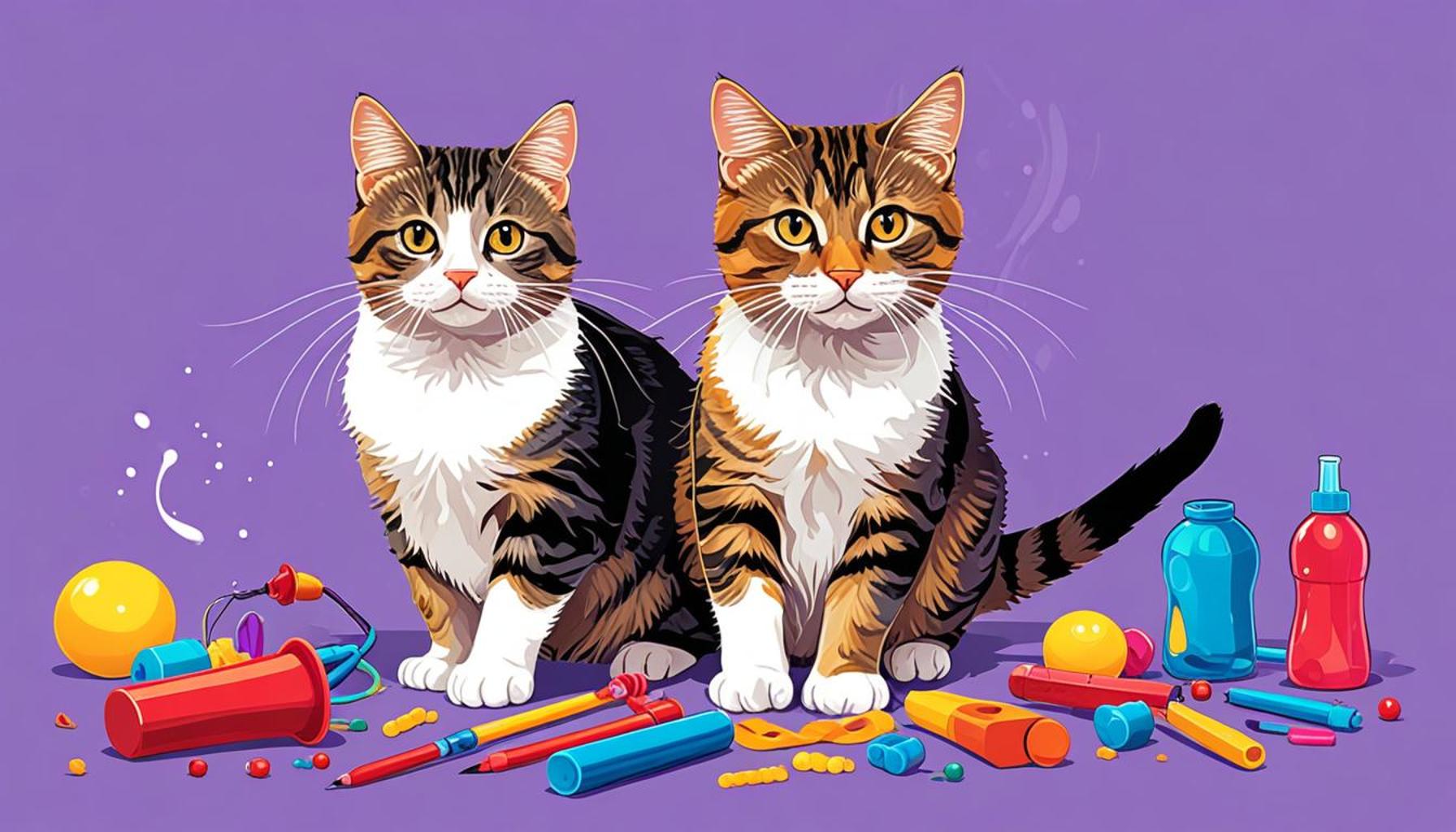Cat Training: Innovative Methods to Teach Basic Commands

The Fascinating World of Feline Communication and Training
Owning a cat often feels like navigating a labyrinth of quirks and behaviors unique to each feline friend. Unlike dogs, who typically respond to commands with eager compliance, cats possess their own intricate language that, when unraveled, opens the door to richer interactions. Understanding this language can significantly enhance your relationship, allowing for more engaging and enjoyable experiences with your cat.
Understanding Innovative Training Methods
Recent advancements in pet psychology and behavioral training have transformed long-held beliefs about cat intelligence and trainability. Innovative methods allow cat owners to teach their pets basic commands and tricks, fostering a deeper connection. Here are some prevalent techniques:
- Clicker training – This method employs a device that makes a distinct sound, signaling to the cat that it has performed the desired action. This positive reinforcement technique is based on operant conditioning, encouraging your cat to repeat the behavior. For example, if you click the device immediately after your cat sits on command, it learns to associate sitting with a reward.
- Treat-based motivation – Food can be a powerful motivator for most pets. By rewarding your cat with its favorite treats after successfully completing a command, such as “shake” or “come,” you reinforce that the behavior is desirable. It’s crucial to use small, low-calorie treats to keep your cat healthy while training.
- Short, positive training sessions – Cats can have short attention spans, so keeping the training sessions brief—no more than 5-10 minutes—ensures they remain engaged and not overwhelmed. Ending a session on a positive note can also encourage your cat to look forward to the next training time.
Unraveling the Training Potential
As ongoing research sheds light on feline behavior, pet owners in the United States are discovering that cats can be trained more effectively than previously assumed. Strategies that offer practical guidance secure the success of the training process. Key aspects include:
- Learning to teach commands like “sit” and “high five” not only entertains but also stimulates your cat mentally. These tricks surprisingly foster your cat’s agility and responsiveness.
- Recognizing the subtle signs that mark a responsive learner is essential. A cat that looks at you directly, responds to its name, or appears relaxed is likely ready to learn. Conversely, if your cat shows signs of stress like hiding or aggressive behavior, it’s best to pause training and try again later.
- Utilizing tools and resources, such as training books, online tutorials, and interactive toys tailored for cats, can bolster your efforts. Various platforms provide additional insights and community support for pet owners looking to improve their training skills.
Regardless of whether you’re a new cat parent or someone seeking to deepen your bond with a beloved pet, embracing these innovative training methods could revolutionize your daily interactions. By investing time in understanding and applying these techniques, you may discover the key to a happier, more harmonious household filled with lively exchanges between you and your furry companion.
LEARN MORE: Click here for insights on stress in pets

Unlocking the Secrets of Cat Training
The journey of training your feline companion is filled with opportunities to deepen the bond you share. Unlike more straightforward pet training, cat training requires a nuanced understanding of their behaviors and preferences. Innovative methods can help bridge the communication gap, making it feasible to teach your cat essential commands such as “sit,” “stay,” and “come.” By exploring these groundbreaking approaches, you can effectively capture your cat’s attention and focus.
Choosing the Right Environment for Training
Creating the right atmosphere is fundamental to successful cat training. Cats thrive in calm environments where they feel safe and secure. A quiet room free from distractions, such as loud noises or other pets, can enhance your cat’s focus during training sessions. Keep in mind the following aspects to improve your training environment:
- Minimize distractions – Turn off the television, move away from noisy appliances, and limit the number of people in the room. This allows your cat to concentrate on the task at hand.
- Utilize familiar settings – Cats often feel more comfortable in spaces they frequent. Training in familiar areas can help reduce anxiety and encourage a more proactive response.
- Incorporate interactive toys – Using engaging toys during training sessions can simulate hunting behavior, making the experience entertaining and rewarding for your cat. Toys that dispense treats can be particularly beneficial.
Establishing a Reward System
Reward-based training is a crucial element of innovative cat training methods. Cats respond exceptionally well to positive reinforcement, which not only encourages desired behaviors but also builds trust between you and your pet. Various forms of rewards can be effective:
- Food rewards – Small portions of your cat’s favorite treats can be a great incentive. The key is to offer rewards immediately after your cat performs the desired command so that the connection between the action and the reward is clear.
- Affection and praise – Cats, like many animals, thrive on social interaction. When your cat successfully completes a command, verbal praise, petting, or simply spending time with your cat as a form of reward can reinforce positive behavior.
- Playtime – Incorporating play as a reward can be an excellent way to motivate your cat. Engaging them in their favorite game after a successful command can help solidify learning while keeping the experience enjoyable.
By fostering a supportive environment and establishing a solid reward system, you’ll create a foundation for successful cat training. The combination of these innovative methods not only teaches your cat essential commands but also enriches their experience, leading to an overall happier and more obedient feline companion. Whether you aim for basic commands or delve into more complex tricks, understanding these building blocks is essential for any cat owner looking to embark on the training journey.
Understanding Innovative Methods for Cat Training
When it comes to effective cat training, innovative methods significantly contribute to ensuring your feline friends grasp basic commands while maintaining a positive atmosphere. Unlike traditional training techniques, which may not cater to a cat’s independent nature, these modern approaches consider the unique behavioral tendencies of cats. Let’s delve deeper into some of these revolutionary techniques.First, clicker training has risen to prominence. This method employs a small device that produces a ‘click’ sound, allowing owners to deliver immediate positive reinforcement after a desired action. The association between the click sound and rewards like treats or affection facilitates quicker learning. This method is particularly effective in teaching basic commands such as “sit” or “stay.”Another technique involves using interactive games and puzzles. By engaging cats in mentally stimulating activities, you can successfully teach commands while ensuring they remain entertained. For instance, using treat-dispensing toys encourages your cat to perform specific actions to receive a reward, making the training process feel like play rather than a chore.Lastly, incorporating scent and sound cues can enhance a cat’s learning experience. For example, cats can be trained to associate certain sounds or scents with specific commands, leading to a broader understanding of basic instructions. By understanding and implementing these innovative training techniques, cat owners can foster a better relationship with their pets while ensuring they learn essential commands, ultimately leading to a more harmonious coexistence.
| Category | Advantages |
|---|---|
| Clicker Training | Promotes immediate positive reinforcement, facilitating faster learning of commands. |
| Interactive Games | Combines play and learning, keeping cats engaged while they master commands. |
| Scent and Sound Cues | Enhances command recognition through multi-sensory associations. |
Integrating these methods into your cat training regime not only enriches your cat’s learning experience but also strengthens the bond between you and your beloved pet. With patience and dedication, any cat can learn to respond to essential commands, making life more enjoyable for both of you.
LEARN MORE: Click here for insights on balanced nutrition
Making Training Fun: Incorporating Play and Enrichment
In the realm of cat training, integrating play and enrichment activities can revolutionize how cats respond to commands. Since cats are natural hunters and explorers, stimulating their instincts through engaging and challenging activities not only enhances their training experience but also makes learning enjoyable. Here are innovative strategies to marry training with play:
Clicker Training: Harnessing Positive Feedback
Clicker training is an innovative method that has gained popularity among cat owners and trainers alike. This technique employs a small handheld device that produces a distinct sound when pressed. The sound serves as an immediate marker, indicating to your cat that they have executed a command correctly:
- Timing is crucial – Just like in traditional training, timing your click is vital. Click the moment your cat performs the desired action, then immediately follow it with a reward.
- Gradual progression – Start with basic commands and gradually increase the complexity as your cat becomes more proficient. This approach keeps your cat engaged and eager to learn.
- Creating associations – Over time, your cat will associate the click sound with a reward, enhancing their eagerness to respond to commands.
Research has shown that clicker training not only improves learning efficiency but also fosters a stronger bond between owner and pet. By teaching a cat to associate the click with positive outcomes, you can strengthen their motivation to learn new behaviors while having fun.
Incorporating Puzzle Feeders for Mental Stimulation
Puzzle feeders are an innovative form of enrichment that challenge a cat’s cognitive abilities. These toys require your cat to solve tasks to access treats or food, adding complexity to their training. Incorporating them into your routine can accomplish two goals simultaneously:
- Encouraging problem-solving skills – As your cat figures out how to manipulate the puzzle feeder, they build essential problem-solving skills that can translate into quicker understanding during command training.
- Translating success to command performance – The reinforcement from solving the puzzle can help your cat feel more accomplished and confident, transferring that energy into their training sessions.
By utilizing puzzle feeders, you not only break the monotony of standardized training but also encourage exploration and cognitive growth, making commands more meaningful.
Short and Sweet Training Sessions
Maintaining your cat’s interest during training sessions is paramount to their success. Short and sweet training sessions, lasting 5 to 10 minutes, can be significantly more effective than prolonged sessions, which can lead to boredom or frustration. Here’s how to structure those sessions:
- Set specific goals – Focus on teaching one command per session. This allows your cat to master one skill before moving on to another.
- Flexible scheduling – Train when your cat is most energetic, usually after playtime or before mealtime. Recognizing their natural rhythms can optimize their responsiveness.
- End on a positive note – Always conclude with a successful command or a fun game, leaving your cat eager for the next session.
Ultimately, creating an engaging training regimen through play and enrichment not only teaches your cat essential commands but also cultivates a respectful and loving relationship. These innovative methods can transform training from a chore into a cherished bonding time, ensuring that both you and your furry friend enjoy the journey of learning together.
Dive deeper: Click here to learn more about balanced nutrition for your pet
Conclusion: A New Approach to Cat Training
In the ever-evolving landscape of cat training, embracing innovative methods can significantly enhance both the learning experience for your feline and the bond you share. By integrating techniques such as clicker training and puzzle feeders, you are not just teaching your cat basic commands; you are igniting their natural instincts and fostering their cognitive abilities. These methods emphasize the importance of positive reinforcement, ensuring that each training session becomes a pleasurable interaction rather than a mundane task.
Moreover, keeping training sessions short and engaging is crucial. By respecting your cat’s attention span and energy levels, you set the stage for success, creating a dynamic learning environment that invites curiosity and enthusiasm. This fresh perspective on training encourages owners to view the process as a shared journey—one filled with discovery, connection, and fun.
Ultimately, cat training isn’t solely about obedience; it’s about establishing a mutual understanding and respect between you and your furry companion. As you explore these innovative strategies, you’ll discover that the path to teaching basic commands can be filled with enriching experiences and delightful surprises. With patience and creativity, you can transform the training journey into a cherished ritual, paving the way for a fulfilling relationship with your beloved pet.


